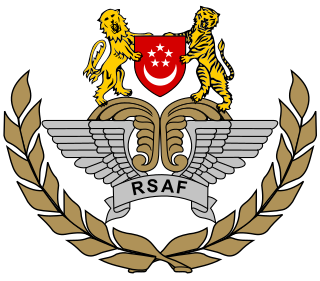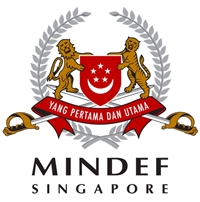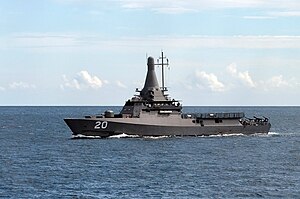
The Republic of Singapore Air Force (RSAF) is the aerial service branch of the Singapore Armed Forces (SAF) responsible for controlling and defending the airspace of the country, and providing air support to the Army and Navy. It was established in 1968 as the Singapore Air Defence Command (SADC) before renaming to its current name in 1975. As one of the most powerful air forces in Southeast Asia, the RSAF has undertaken a significant role in Singapore's military defence strategy since its formation.

The Singapore Armed Forces (SAF) are the military services of the Republic of Singapore, responsible for protecting and defending the security interests and the sovereignty of the country. A military component of the Ministry of Defence (MINDEF), the armed forces have four service branches: the Army, the Navy, the Air Force, and the Digital and Intelligence Service. An integrated force, it is one of the most capable, robust, technologically sophisticated and powerful militaries in Southeast Asia and the surrounding regions. The SAF is headed by the chief of defence force, appointed by the president of Singapore, on the advice of the Cabinet.

The Republic of Singapore Navy (RSN) is the maritime service branch of the Singapore Armed Forces (SAF) responsible for defending the country against any seaborne threats and as a guarantor of its sea lines of communications. The RSN traces its origins to the Royal Navy when Singapore was still a crown colony of the British Empire. The service was formally established in 1967, two years after its independence from Malaysia in 1965, and had undergone a substantial modernisation ever since – which has led them into becoming the most powerful navy in Southeast Asia.

The Ministry of Defence is a ministry of the Government of Singapore responsible for overseeing the national defence of Singapore.

The Formidable-class multi-role stealth frigates are multi-mission derivatives of the French Navy's La Fayette-class frigate with the Republic of Singapore Navy. The six ships form the First Flotilla of the Navy.

The Endurance-class tank landing ships (LST) are the largest class of ships in the Republic of Singapore Navy (RSN). They were designed and built by Singapore Technologies (ST) Marine to replace the old County-class tank landing ships. The four ships form the Third Flotilla of the RSN.

The Fearless-class patrol vessels were built by Singapore Technologies (ST) Marine for the Republic of Singapore Navy (RSN) in the 1990s. Four remain in service with the RSN as modified Sentinel-class Maritime Security and Response Vessels (MSRVs), while derivatives of the type are also in service in the navies of Brunei, Oman and the United Arab Emirates.

The Bedok class are mine countermeasures vessels of the Republic of Singapore Navy (RSN). They play an important role in the maritime security of Singapore, ensuring that the Singapore Strait and the sea lanes surrounding Singapore remain mine-free and open to international shipping. It is estimated that closure of Singapore's ports would result in direct trade losses amounting to more than US$1.2 billion daily, posing a serious threat to Singapore's economy. The four ships form the Sixth Flotilla of the RSN.

The Freedom class is one of two classes of the littoral combat ship program, built for the United States Navy.

The Victory-class corvettes are multi-purpose corvettes based on the MGB 62 design by Germany's Lürssen shipyard for the Republic of Singapore Navy (RSN). The six ships were commissioned between 1990 and 1991 and form the Eighth Flotilla of the RSN.

USS Coronado (LCS-4) is an Independence-class littoral combat ship. She is the third ship of the United States Navy to be named after Coronado, California.

USS Little Rock (LCS-9) was a Freedom-class littoral combat ship (LCS) of the United States Navy. She is the second ship named after Little Rock, the capital city of Arkansas.
The Invincible-class submarines, formally classified as the Type 218SG submarines, is a class of conventionally-powered attack submarines, ordered by the Republic of Singapore Navy (RSN) from German-based naval conglomerate ThyssenKrupp Marine Systems (TKMS). The Type 218SG is an extensively-customised derivative of the export-oriented Type 214 submarine, with specific design characteristics drawn from Type 212 submarines. They feature several capabilities, including a substantial level of automation, a significant payload capacity, enhanced underwater endurance and superlative ergonomics.

USS Wichita (LCS-13) is a Freedom-class littoral combat ship of the United States Navy, the third ship named after Wichita, the largest city in Kansas.

The Keris-class are a class of large patrol vessels of the Royal Malaysian Navy (RMN) with a length of 69 metres and displacing 700 tons. A total of 18 ships are planned. As of 2018, four ships have been funded by the Malaysian government.

Endurance(207) is the lead ship of the Endurance-class landing platform dock of the Republic of Singapore Navy.

HTMS Angthong (LPD-791) is a Royal Thai Navy amphibious ship based on the design of Endurance-class landing platform dock of the Republic of Singapore Navy.

















